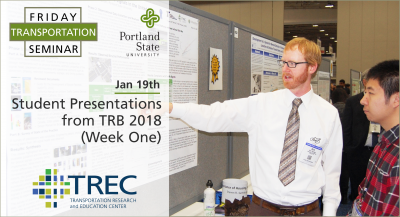
*NEW* LOCATION: Karl Miller Center at PSU, 631 SW Harrison St., Room 465
*NEW* REGISTRATION: Sign up through GoToWebinar
SEMINAR VIDEO
HUAJIE YANG
Huajie Yang is a PhD student in the Nohad A. Toulan School of Urban Studies & Planning at Portland State University. His research interests include integrated transportation and land use modeling, and the impact of transit on traffic congestion. Now he is working on a project that investigates approaches incorporating emerging travel modes in the Regional Planning Model (RSPM) tool with Dr. Liming Wang.
Development of a Multi-modal Travel Demand Module for the Regional Strategic Planning Model
Integrated land use and transportation models have evolved along a spectrum with simplistic sketch planning models on one end and sophisticated microsimulation models on the other. While each type of these models has its niche, they are largely unable to balance the flexibility and realism of microsimulation and the speed and interactiveness of simple models. The Regional Strategic Planning Model (RSPM) aims to fill this gap by taking a microsimulation approach but making other simplifications, to model first-order long-term outcomes of land use and transportation quickly. It takes into consideration the underlying uncertainties of long-term modeling by accepting a broad range of policy inputs and technology assumptions while allowing rapid simulations of hundreds of scenarios. The RSPM is one of a few operational modeling packages (along with EERPAT and RPAT) that have evolved from GreenSTEP, a microsimulation modeling package for state-level evaluation of strategies for reducing transportation energy consumption and greenhouse gas (GHG) emissions. Several ongoing projects are aiming to develop a common software framework for the family of strategic modeling tools and improve the policy sensitivity of multi-modal travel. In this study, we introduce the RSPM framework, and then primarily focus on the new development of a multi-modal travel demand module that links various policy inputs to households’ multi-modal travel and further to aggregate transportation outcomes (e.g. GHG emissions, traffic fatalities). We discuss our choice of model structures and specifications and then estimate the models utilizing a unique US nationwide dataset combining the 2009 US National Household Travel Survey (NHTS), EPA’s Smart Location Database, and the National Transit Database. This comprehensive dataset provides a rich set of variables capturing household social-demographics, multi-modal travel, built environment, and transportation supply. We conclude the paper with the results of validation and sensitivity tests, and a discussion of future work.
ALVARO CAVIEDES
Exploring the Determinants of Vulnerable Road Users’ Crash Severity in State Roads
Pedestrians and bicyclists are the most vulnerable road users and suffer the most severe consequences when crashes take place. An extensive literature is available for crash severity in terms of driver safety, but fewer studies have explored non-motorized users’ crash severity. Furthermore, most research efforts have examined pedestrian and bicyclist crash severity in urban areas. This study focuses on state roads (mostly outside major urban areas) and aims to identify contributing risk factors of fatal and severe crashes involving pedestrians and bicyclists in state roads. The results seem to suggest that besides improvements in roadway characteristics, additional countermeasures to reduce crash severity for vulnerable users should include educational campaigns, more strict control of alcohol intoxicated drivers, and protection strategies of senior pedestrians.
PROFESSIONAL DEVELOPMENT
This 60-minute seminar is eligible for 1 hour of professional development credit for AICP (see our provider summary). We can provide an electronic attendance certificate for other types of certification maintenance.
GET UPDATES
Sign up for our newsletter and check the box for "Online Events" to receive monthly updates.
